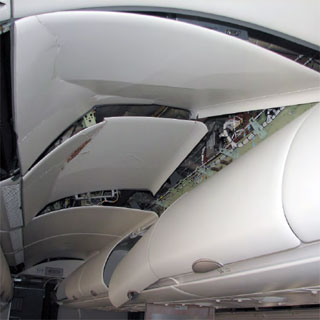
Qantas Airbus A330-303 (VH-QPA) flight QF72 – view of the cabin ceiling.
Qantas flight QF72 : at 0132 Universal Time Coordinated (0932 local time) on 7 October 2008, an Airbus A330-303 aircraft, registered VH-QPA and operated as Qantas flight 72, departed Singapore on a scheduled passenger transport service to Perth, Western Australia. At 0440:26, while the aircraft was in cruise at 37,000 ft, ADIRU 1 started providing intermittent, incorrect values (spikes) on all flight parameters to other aircraft systems.
Soon after, the autopilot disconnected and the crew started receiving numerous warning and caution messages (most of them spurious). The other two ADIRUs performed normally during the flight.
At 0442:27, the aircraft suddenly pitched nose down. The FCPCs commanded the pitch-down in response to AOA data spikes from ADIRU 1. Although the pitch-down command lasted less than 2 seconds, the resulting forces were sufficient for almost all the unrestrained occupants to be thrown to the aircraft’s ceiling. At least 110 of the 303 passengers and nine of the 12 crew members were injured; 12 of the occupants were seriously injured and another 39 received hospital medical treatment. The FCPCs commanded a second, less severe pitch-down at 0445:08.
The flight crew’s responses to the emergency were timely and appropriate. Due to the serious injuries and their assessment that there was potential for further pitch-downs, the crew diverted the flight to Learmonth, Western Australia and declared a MAYDAY to air traffic control. The aircraft landed as soon as operationally practicable at 0532, and medical assistance was provided to the injured occupants soon after.
During the upset, the FDR recorded a peak vertical acceleration of -0.80 g. A significant number of occupants were thrown around the cabin.
- There was a limitation in the algorithm used by the A330/A340 flight control primary computers for processing angle of attack (AOA) data. This limitation meant that, in a very specific situation, multiple AOA spikes from only one of the three air data inertial reference units could result in a nose-down elevator command.
- When developing the A330/A340 flight control primary computer software in the early 1990s, the aircraft manufacturer’s system safety assessment and other development processes did not fully consider the potential effects of frequent spikes in the data from an air data inertial reference unit.
- One of the aircraft’s three air data inertial reference units (ADIRU 1) exhibited a data-spike failure mode, during which it transmitted a significant amount of incorrect data on air data parameters to other aircraft systems, without flagging that this data was invalid. The invalid data included frequent spikes in angle of attack data. Including the 7 October 2008 occurrence, there have been three occurrences of the same failure mode on LTN-101 ADIRUs, all on A330 aircraft.
- The LTN-101 air data inertial reference unit involved in the occurrence (serial number 4167) also had a previous instance of the data-spike failure mode, indicating that it probably contained a marginal weakness in its hardware, which reduced the resilience of the unit to some form of triggering event.
- For the data-spike failure mode, the built-in test equipment of the LTN-101 air data inertial reference unit was not effective, for air data parameters, in detecting the problem, communicating appropriate fault information, and flagging affected data as invalid.
- The air data inertial reference unit manufacturer’s failure mode effects analysis and other development processes for the LTN-101 ADIRU did not identify the data-spike failure mode.
- Although passengers are routinely reminded to keep their seat belts fastened during flight whenever they are seated, a significant number of passengers have not followed this advice. At the time of the first in-flight upset, more than 60 of the 303 passengers were seated without their seat belts fastened.
Download Report

0 Comments